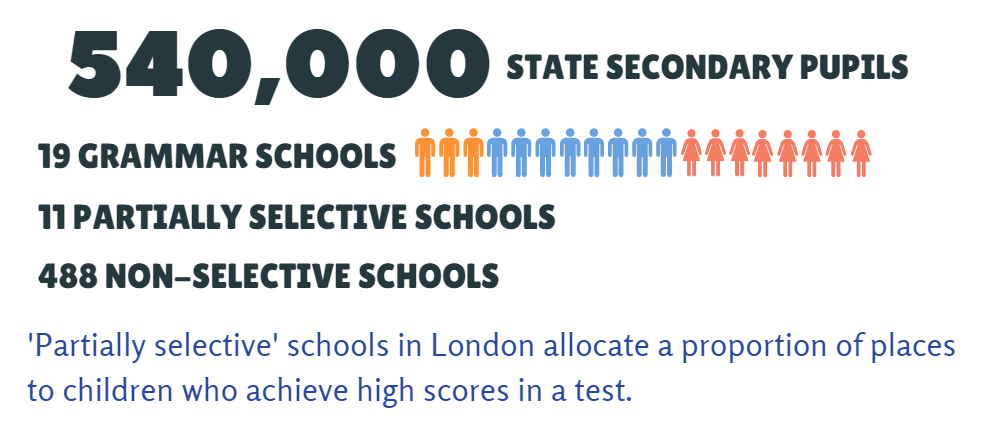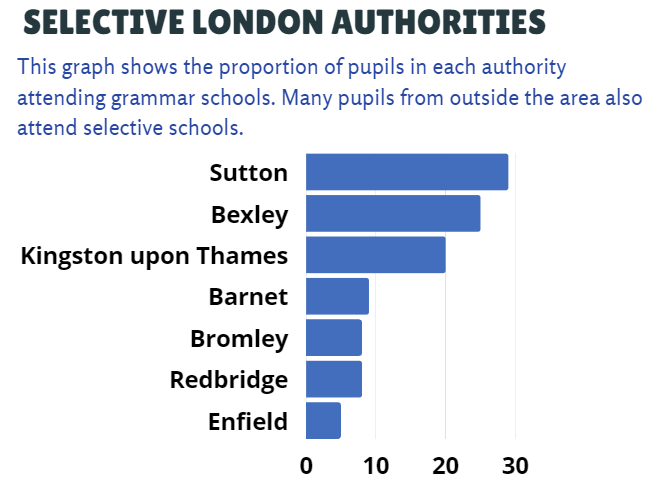 Selective education guide – London and Greater London
Selective education guide – London and Greater London
BACKGROUND
There are 19 grammar schools in London and Greater London, located in the following boroughs.
Barnet: 3 selective schools (1 boys, 2 girls’ schools.)
Bexley: 4 selective schools (1 boys, 1 girls, 2 mixed schools.)
Bromley: 2 selective schools (1 boys. 1 girls’ school.)
Enfield: 1 selective school (mixed.)
Kingston upon Thames: 2 selective schools (1 boys, 1 girls’ school.)
Redbridge: 2 selective schools (1 boys, 1 girls’ school.)
Sutton: 5 selective schools (3 boys, 2 girls’ schools.)
To find out more about selective schools in London, check out our interactive map of England where you can find out about the percentage of disadvantaged pupils, the percentage of pupils attending a grammar school who are likely to have come from a fee-paying ‘prep’ school, and the relative selectivity of every grammar school. View the map HERE.
Or, to read stories from parents and teachers experiencing selective education in London visit the 11+ Anonymous website HERE.
THE PROBLEMS
In every area where academic selection still exists there are some common problems. For example,
- Grammar schools admit fewer disadvantaged pupils than non-selective schools. Grammar schools are also more likely to admit pupils from more advantaged families pupils
- A significant number of pupils previously educated in fee-paying ‘prep’ schools take up grammar school places.
- Tuition for the 11-plus ‘buys advantage’. Better-off families can afford private coaching while poorer families feel compelled to pay for tuition they can ill afford.
- Sitting the 11-plus is stressful and can damage a child’s confidence.
- The 11-plus has been proven to lack accuracy because it takes place while children are still developing academically.
- Research shows the proportion of children with Special Educational Needs (SEN) attending grammar schools is small. For many children with additional learning needs such as dyslexia and attention deficit disorders, the 11-plus test is inaccessible. The same children often perform very well academically outside a test situation.
- Grammar schools change the pupil profile of other schools in the area. If a large number of higher attaining pupils attend grammar schools then surrounding schools find themselves with a pupil population which is skewed, with a disproportionate amount of moderate and lower attaining pupils and pupils with additional learning needs. This impacts on subject choice (fewer subjects available than at a grammar school) and teacher recruitment. Non-selective schools in areas with grammar schools cannot be ‘true’ comprehensives and tend to underperform compared to comprehensive schools.
- GCSE results in areas with grammar schools are on a par, or worse, than areas that have only comprehensive schools. Research has shown that children who attend selective schools would be likely to achieve broadly the same results in a comprehensive school.
London’s selective schools affect other schools
Although there are relatively few grammar schools in London there will be an impact on surrounding schools.
Grammar schools change the profile of surrounding secondary schools. It is inevitable that the schools around grammar schools will admit a smaller proportion of high attaining pupils. In highly selective areas like Sutton and Bexley more than one in four higher attaining pupils attend grammar schools.
Pupils in London often travel across borough boundaries to attend selective schools, so the impact will be felt in many neighbouring authorities.
A social divide in London secondary schools
England’s primary schools are inclusive schools where children from a diverse range of backgrounds are successfully educated together. In common with many selective schools, London’s grammar schools educate very few disadvantaged pupils. Grammar school pupils tend to come from more comfortably off families who can afford expensive coaching to help them pass the 11-plus. A relatively large proportion of pupils (as high as 21% in some London schools) gain a grammar school place having attended a fee-paying ‘prep’ school. Selective schools in London create social division because children from more affluent backgrounds tend to cluster in these schools, while non-selective schools educate many more children from low-income families.
A similar social divide is seen in every secondary school located in a London borough containing selective schools.
Problems with the 11-plus test
Some London grammar schools are the only selective school in their area. Such schools tend to be highly selective, accepting pupils who pass the 11-plus with only the very highest scores. Schools containing a disproportionate number of high-achieving pupils appear ‘better’ than other schools. The concentration of only higher-achieving pupils tends to boost GCSE and A level results which leads to greater numbers progressing to ‘elite’ universities such as Oxbridge. Although such ‘success’ is engineered through selection, highly selective schools are rewarded with high rankings in league tables. In areas with more grammar schools, such as Sutton or Bexley, a higher proportion of pupils pass the 11-plus and overall grammar school attainment tends to be lower. These selective schools have noticeably less ‘spectacular’ results.
There are almost as many different 11-plus tests as there are London grammar schools. Some groups of schools share a test, such as the Sutton grammars who use the Selective Eligibility Test (SET.) There is little transparency about the 11-plus, with no requirement made of grammar schools to explain why they choose a particular type of test. Some tests give equal weight to English, maths, and IQ style test questions, while others prioritise written work and comprehension. It is quite possible for a child in London to pass one selection test only to fail another. In other words, the idea that there is a ‘grammar school standard’ is a myth. London’s grammar schools have an academic ‘standard’ which varies depending on the school and its area.
As in all selective areas, 11-plus test tuition is common in London, with prices charged by tutors as much as £80 an hour. Some London grammar school Parents Associations profit by selling tickets to ‘mock’ 11-plus tests at a cost of £60 or more per child. This unusual type of fundraising can raise as much as £60,000 a year. Although many schools offer low-cost or free places to disadvantaged pupils in these mock tests, it is questionable whether a state school should profit from its entrance processes in this way.
Time to end selective education
At 10 years, the age at which most children sit an entrance test, a child is still developing academically. Most people agree that 10 is far too young for a child to take a test which decides her/his future schooling. In London, as in all selective areas, many young children face the additional pressure of tuition for the 11-plus. If the family hopes for a place at a highly selective grammar school, tuition can be demanding and excessive.
The 11-plus is a wholly unnecessary, outdated, and stressful test. Grammar schools are not ‘better’ schools, they simply select higher-attaining children who, all the evidence shows, would perform equally well in comprehensive schools. Comprehensive Future believes it is time to phase out the 11-plus and end selective education.
More information
You can read more information about the format and dates for London grammar school’s 11-plus tests on the individual school websites, there are usually links on local authority websites.
Want to end the 11-plus in London?
Join Comprehensive Future’s campaign to end the 11-plus.
To learn about the data sources for our interactive map and selective education guides click here. If you spot any errors in the data for any area, please let us know.






